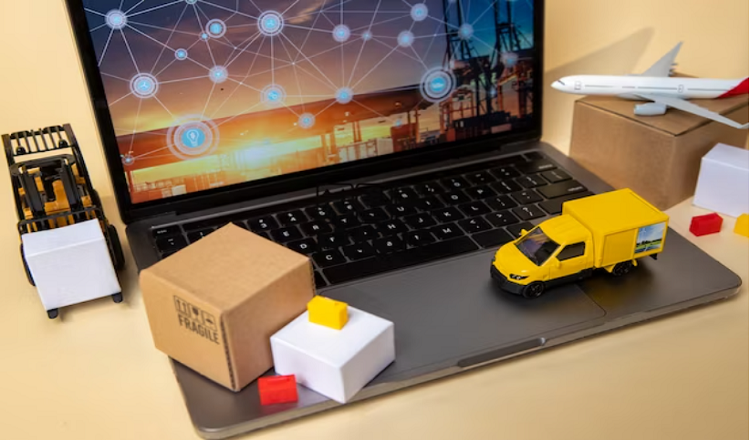Welcome to the exciting world of supply chain management and logistics, where every day is an adventure in ensuring that goods are delivered on time, every time. However, while the industry is full of high stakes and excitement, it is not without its challenges. From product tracking to inventory management, stakeholders in supply chain management face a myriad of issues that can slow down their operations and create inefficiencies. But, fear not! The latest buzzword in the industry is blockchain, and it just might be the solution everyone has been waiting for.
At its core, blockchain is a decentralized and distributed digital ledger that is used to record transactions securely and transparently. Blockchain technology is a game-changer for the supply chain management and logistics industry, offering a host of benefits, such as increased transparency, traceability, and security. With blockchain, stakeholders can track products at every stage of the supply chain, from raw materials to the final product, and easily access data on their provenance, quality, and ownership. This technology can help to reduce fraud, improve inventory management, and streamline supply chain finance, among other benefits. So, if you’re ready to take your supply chain management game to the next level, it’s time to learn more about the exciting world of blockchain!
Benefits of Using Blockchain in Supply Chain Management
One of the biggest advantages of using blockchain in supply chain management and logistics is increased transparency. With blockchain, stakeholders can easily track products at every stage of the supply chain, from raw materials to the final product, and access data on their provenance, quality, and ownership. This increased transparency can help to reduce fraud, improve accountability, and build trust between supply chain partners.
Another key benefit of blockchain in supply chain management is traceability. By using blockchain technology, businesses can track products through every step of the supply chain, creating an unbroken chain of custody. This enables stakeholders to quickly identify and address any issues that arise, such as product recalls, and minimize the impact on customers.
In addition to increased transparency and traceability, blockchain also offers greater efficiency and security. By digitizing supply chain data and automating processes, blockchain can help to reduce errors, save time, and streamline operations. Furthermore, the decentralized nature of blockchain technology makes it highly secure, with data stored across multiple nodes that are almost impossible to tamper with or hack. Real-life examples of successful blockchain implementations in supply chain management include Walmart’s food traceability project and Maersk’s TradeLens platform, which has improved the efficiency and transparency of the global shipping industry
Use Cases of Blockchain in Supply Chain Management
Blockchain technology has many potential use cases in supply chain management and logistics. One key application is product tracking and tracing, which enables stakeholders to follow products from the point of origin to the end customer. By using blockchain, businesses can create an immutable record of every transaction and transfer of ownership, increasing transparency and traceability.
Inventory management is another area where blockchain can be used. By digitizing inventory records and automating processes, businesses can improve efficiency and accuracy, reducing the risk of stockouts or overstocking.
In addition, blockchain can be used in supply chain finance, where it can help to streamline payment processes, reduce fraud, and improve access to credit. Finally, blockchain can be used for data sharing, enabling stakeholders to securely exchange data and collaborate in real-time. Overall, the potential use cases of blockchain in supply chain management and logistics are vast, and we are only scratching the surface of what is possible.
Challenges and Limitations of Using Blockchain in Supply Chain Management
Despite its potential benefits, blockchain implementation in supply chain management and logistics can be challenging. One key limitation is the high cost of implementing and maintaining blockchain technology, which can be prohibitive for some businesses. Scalability is also an issue, as current blockchain solutions may not be able to handle the volume of transactions required in large supply chain networks.
Resistance to change is another challenge, as stakeholders may be hesitant to adopt new technologies or change established business practices. This can make it difficult to achieve widespread adoption of blockchain in supply chain management.
Possible solutions to these challenges include finding cost-effective ways to implement blockchain technology, developing more scalable solutions, and investing in education and training programs to increase stakeholder adoption. Additionally, demonstrating successful use cases and building partnerships across the supply chain ecosystem can help to overcome resistance to change and encourage widespread adoption of blockchain technology
Regulations and Standards
Regulatory frameworks for blockchain in supply chain management and logistics are still evolving, and different countries and industries are taking different approaches. Some countries have been proactive in developing regulations and standards for blockchain, while others have been slower to act.
One key issue that needs to be addressed is the interoperability of different blockchain solutions, which can help ensure that data is shared across different platforms and networks. Additionally, there is a need for greater standardization of data formats and protocols to enable seamless integration with existing systems.
Another important issue is data privacy and security, as blockchain technology involves the sharing of sensitive data across multiple parties. To address this, regulators need to establish clear guidelines and standards for data protection and cyber security.
Overall, as blockchain adoption in supply chain management and logistics continues to grow, regulatory frameworks will need to keep pace and evolve to ensure that the technology is used responsibly and ethically.
Future of Blockchain in Supply Chain Management
The future of blockchain in supply chain management and logistics looks promising, as new trends and innovations continue to emerge. One key trend is the use of smart contracts, which can automate contract execution and ensure compliance with predefined rules and conditions. Another trend is the integration of blockchain with the Internet of Things (IoT), which can enable real-time tracking and monitoring of goods and assets.
Artificial intelligence (AI) is also expected to play an increasingly important role in supply chain management, with the potential to improve forecasting accuracy, optimize inventory management, and reduce costs. In addition, new blockchain solutions and applications are likely to emerge as the technology continues to mature.
Overall, the future of blockchain in supply chain management and logistics is exciting, and the industry is expected to see continued growth and innovation in the coming years
Conclusion
In conclusion, blockchain technology offers numerous benefits for supply chain management and logistics. It can increase transparency, traceability, efficiency, and security, while also reducing costs and improving customer satisfaction. Specific use cases of blockchain in supply chain management include product tracking and tracing, inventory management, supply chain finance, and data sharing. However, implementing blockchain in supply chain management can also be challenging due to high costs, scalability issues, and resistance to change. To overcome these challenges, businesses can explore cost-effective implementation options, invest in education and training programs, and develop partnerships with other stakeholders across the supply chain ecosystem.
Looking to the future, emerging trends and innovations such as smart contracts, IoT, and AI are expected to further enhance the benefits of blockchain in supply chain management and logistics. As blockchain adoption continues to grow, businesses that are considering adopting blockchain technology should carefully evaluate their needs, assess potential benefits and challenges, and develop a clear implementation plan that aligns with their strategic objectives. Overall, blockchain technology has the potential to transform the supply chain management and logistics industry, and businesses that embrace this technology can gain a competitive advantage in the marketplace.




